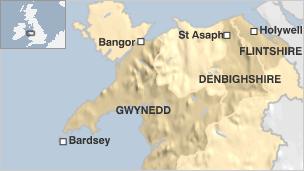Archbishop of Canterbury backs Wales' new Pilgrim's Way
- Published

Archbishop of Canterbury has become North Wales Pilgrim's Way
The Archbishop of Canterbury has backed plans for a 110 mile (177km) pilgrim trail across north Wales.
The path starts at Holywell's holy well in Flintshire and links to a pilgrim route on the Lleyn peninsula, ending at nearby Bardsey Island.
Called the "island of 20,000 saints" after those reputed to be buried there, Bardsey has been an important pilgrim place for centuries.
Dr Rowan Williams, who is from Swansea, has become patron of the new path.
He said: "North Wales is a landscape charged with a history of faith, and this particular pilgrim route will be, for all who follow it, a true path towards the light, supported by all those living memories of prayer and holy lives."
The route, the North Wales Pilgrim's Way, has been devised by the Dean of St Asaph, the Very Revd Chris Potter and his wife, Jenny.
The first pilgrimage takes place this summer, starting from the 12th Century Cistercian Basingwerk Abbey, near Holywell's St Winefride's Well, known as the Lourdes of Wales.

The route stretches from Holywell in the north east to Bardsey island
The route follows places connected with St Winefride, who, according to legend, was beheaded and then brought to life by St Beuno.
It follows the trail west:
Gwytherin - where Winefride became abbess - via Pantasaph Friary
Maen Achwyfan, an ancient stone obelisk
Y Gop, a Bronze Age mound at Trelawnyd, near Dyserth
St Beuno's College at Tremeirchion
St Asaph Cathedral
Llangernyw - its historic churchyard with a 4,000 year old yew tree
Eglwysbach village
Talycafn, crossing the River Conwy
Cefn Coch and an ancient stone circle at Cefn Coch, before following the North Wales Path
Bangor Cathedral
Caernarfon Castle and Clynnog Fawr, where St Beuno established his church
Bardsey Island
It is hoped the Pilgrim's Way will also help to boost tourism in rural areas of the region.